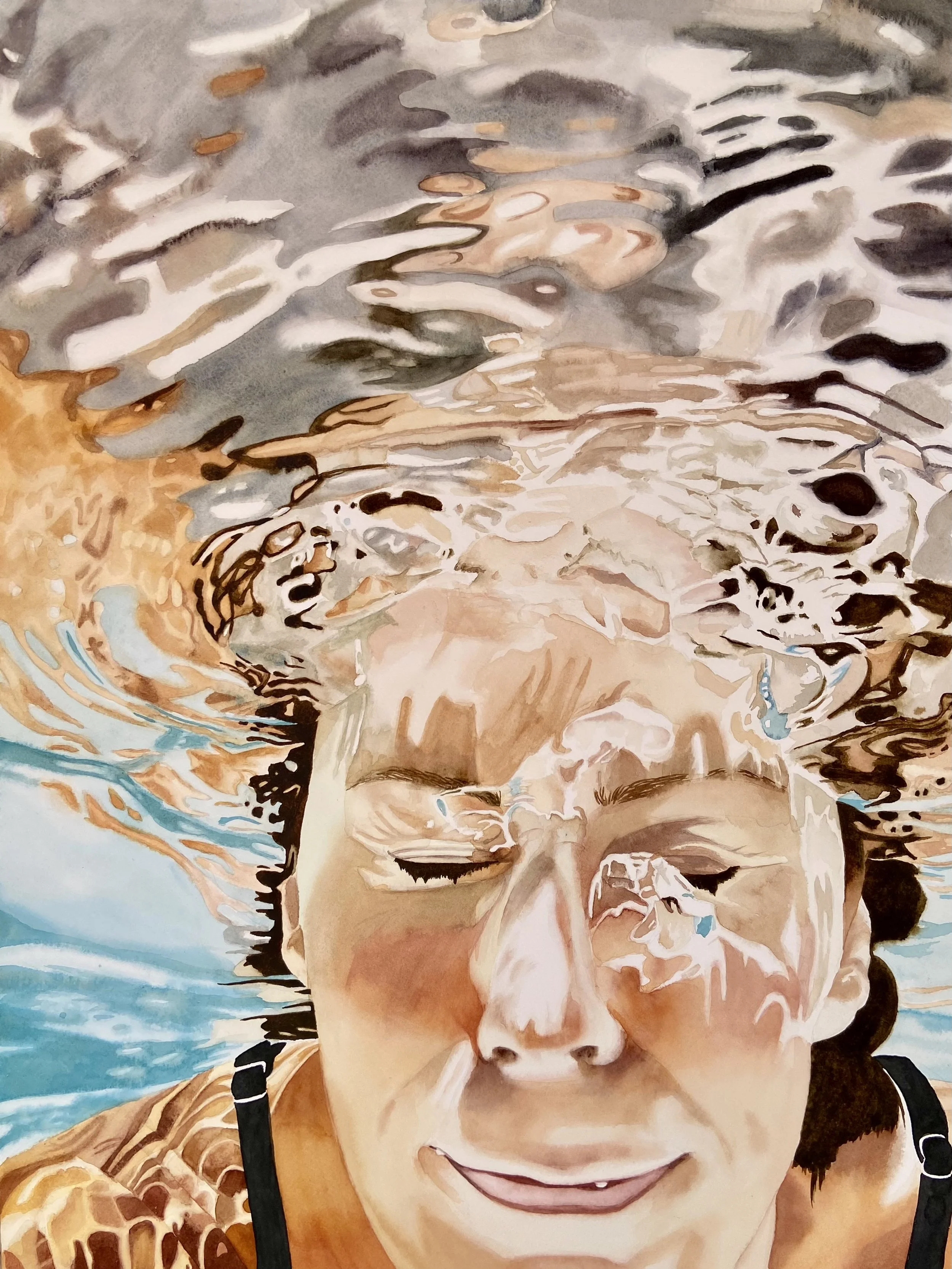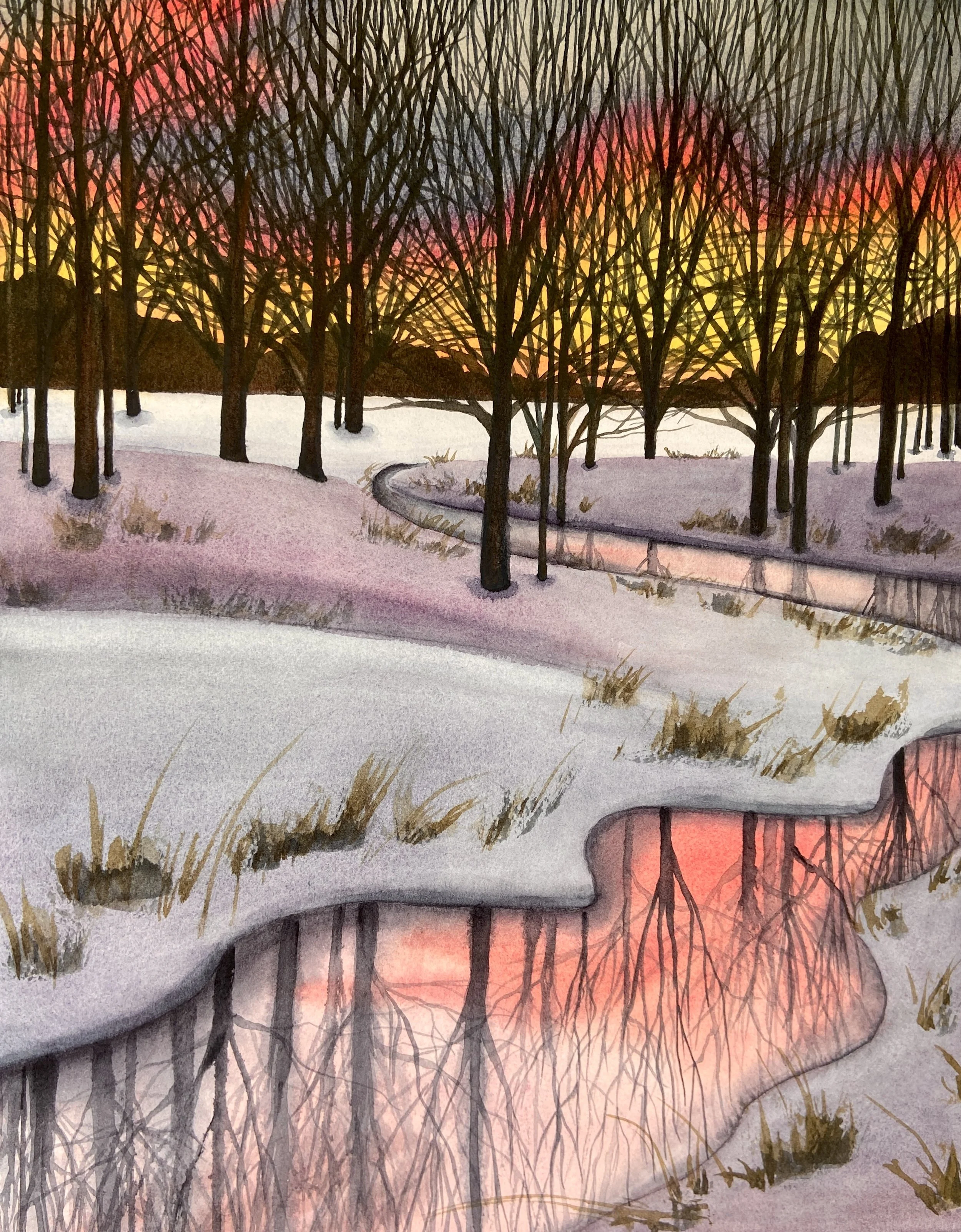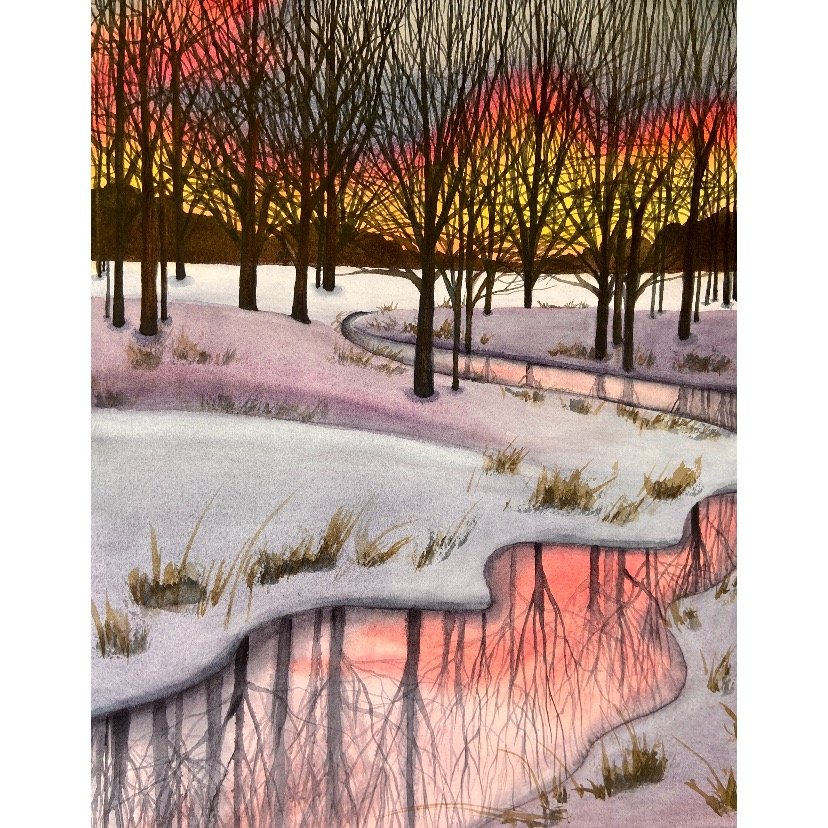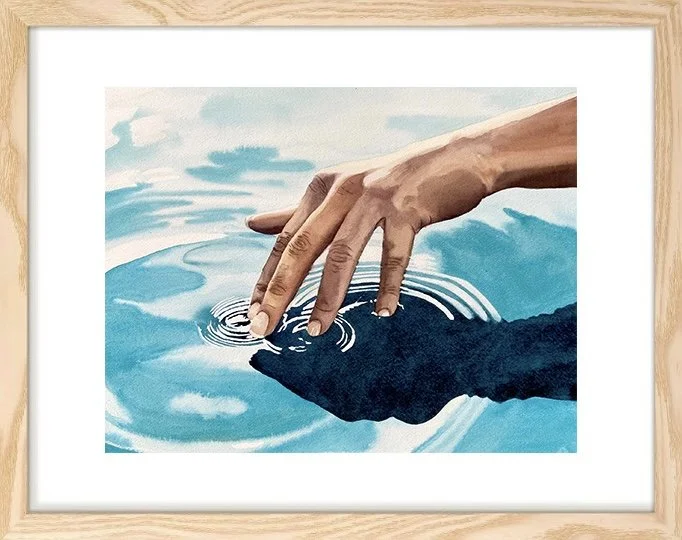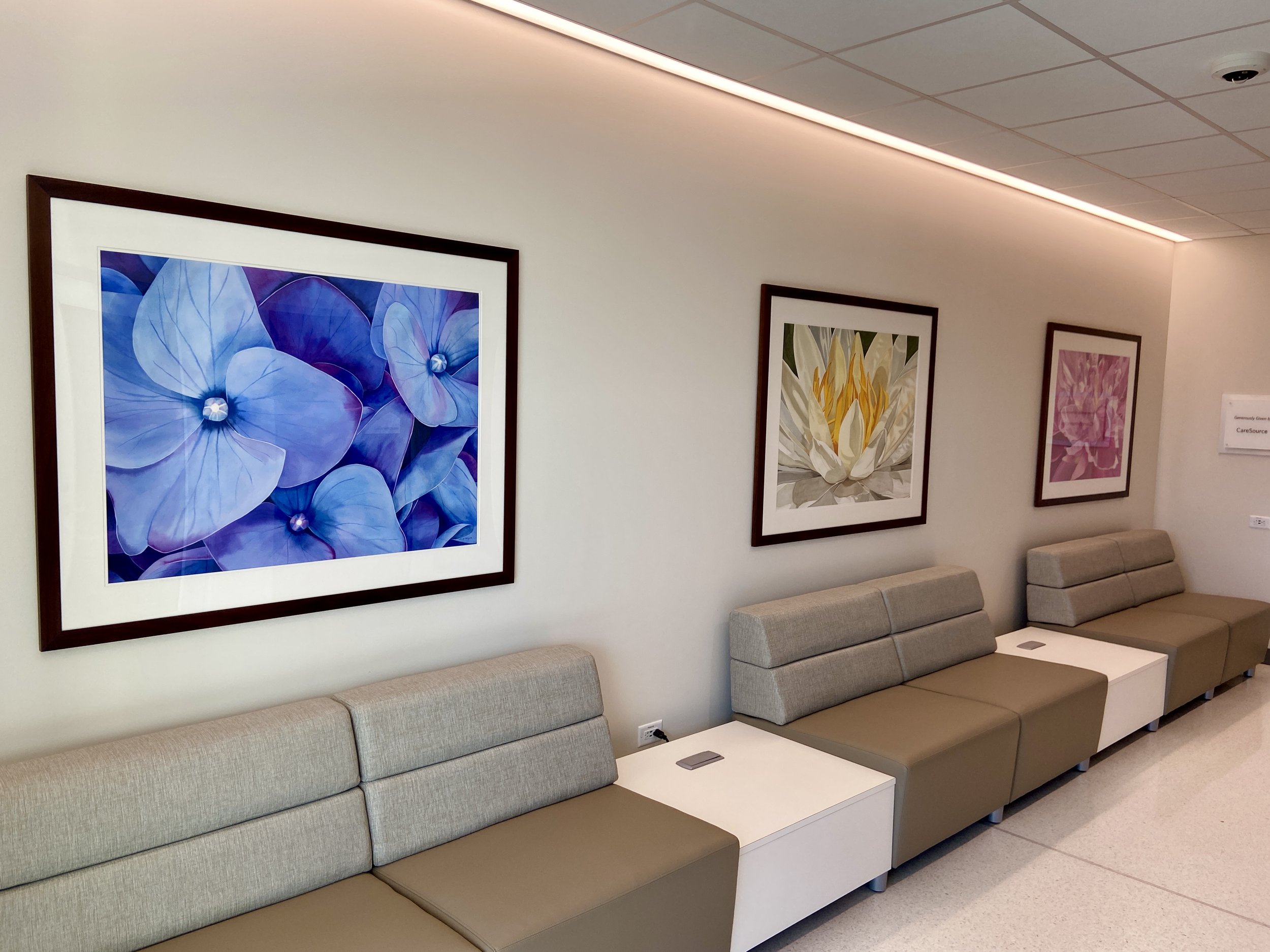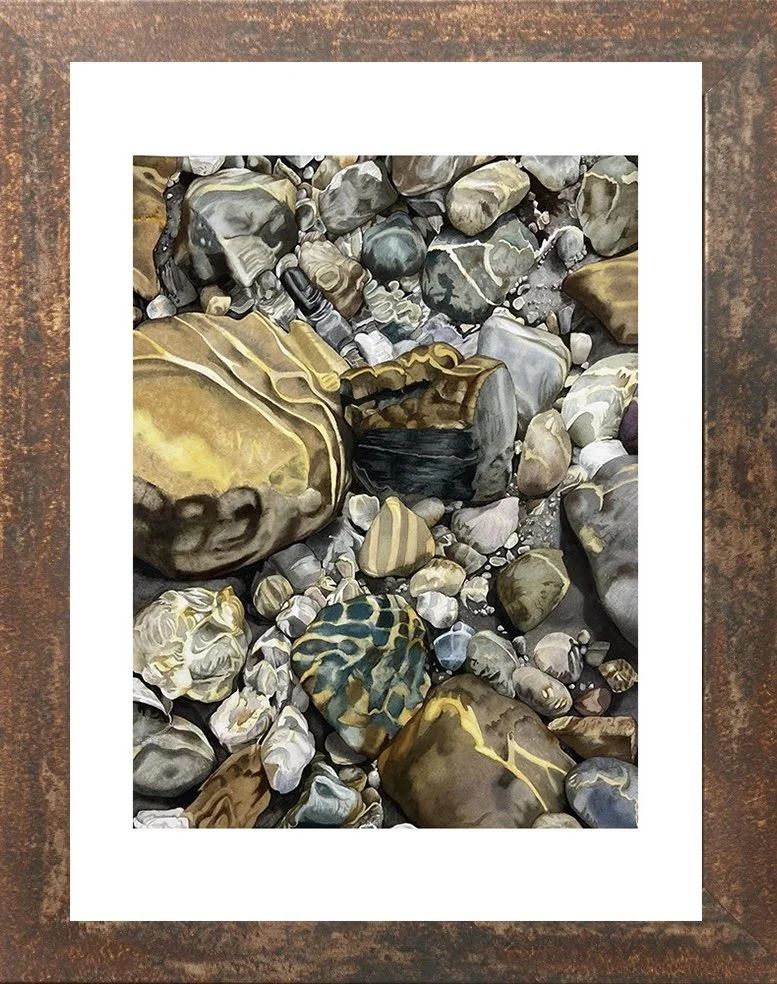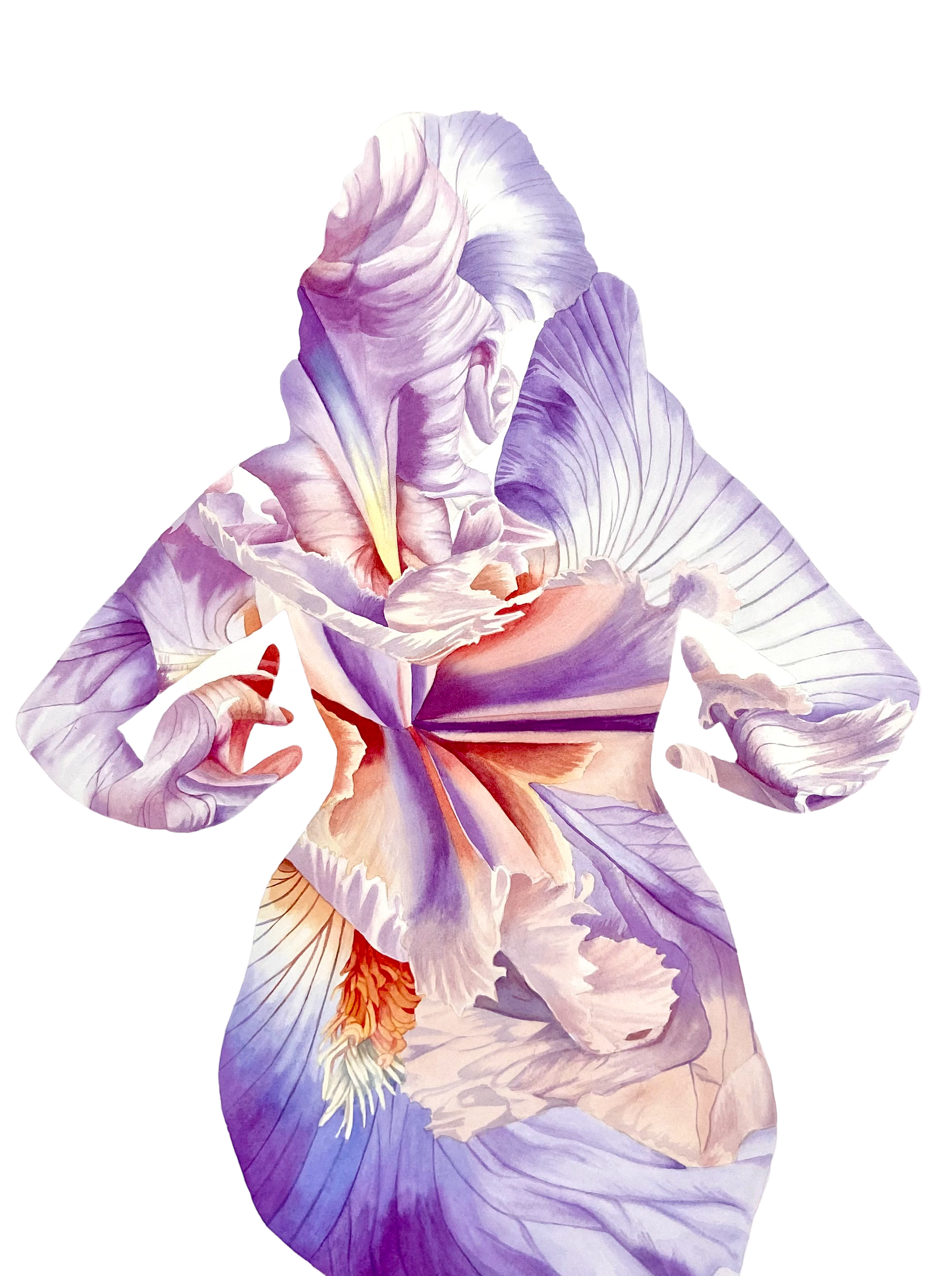Summer 2025 Studio Updates
“The Peace Within”, 18x24”, watercolor
43rd Annual Juried Exhibit for the Watercolor Society of Indiana
Hanging in the Indianapolis Museum of Art September/October
It’s been a while so I thought I’d catch everyone up on things over here in the Studio this summer.
I’ve been unveiling my “Underwater Series” over on my social media this season. I’ve been working on it for over a year, but thought I’d wait to roll it out until the weather was warmer. I’ve gotten a really good reception on it so far, and for that I’m grateful. Three of the pieces are hanging in a show called “Poolside Gossip” at Cafe Oztara (affiliated with the Damien Center) here in Indianapolis.
I also just got word that, “The Peace Within” (pictured), just got accepted into the 43rd Annual Juried Exhibit for the Watercolor Society of Indiana. This is the fourth year in a row that I’ve been juried in, and honestly getting that acceptance letter never gets old, and I am flabbergasted each time a different judge sees the beauty in what I do. The show hangs at The Indianapolis Museum of Art at Newfields during the months of September and October. What a cool feeling!
I also recently found out that I will be published in CREATE! Magazine for their Lightness of Being issue. This is my first publication, so I’m extremely excited about it and will have more information soon.
Some of you may know that I live with an extremely painful disease that affects my joints and my autonomic nervous system . It makes living in this world challenging in so many ways. I found that being in water relieves some of the pain, and the gentle rocking of my body in the water seems to soothe my nervous system. Last year I wanted to encapsulate that in a painting, so I set about getting some reference photos as inspiration. I was even able to get a few of myself.
I’ve been painting flowers and botanicals for so long (still am!) that I knew painting water was going to be a new challenge for me. I also thought it would be cool to do an underwater series with such a fluid water-based medium like watercolor. I practiced quite a bit in my watercolor sketchbook and once I felt like I got the hang of it, I started on bigger paper. Technique aside, I fell in love with the way sunlight reflects on and through the water. I became mesmerized by how the reflection of the body was distorted in the reflection of the water and all of the different meanings one can glean from the symbolism of it.
My son and I took a trip to the Indiana Dunes a couple summers ago (I had never been!) and I took my sister there this summer. I realized that even though I’m landlocked in the Midwest, there is still a large body of water relatively close by that feels very much like the ocean. The older I get, the more I am drawn to the water; the relief it brings to my physical condition is better than any medicine that can be bottled.
This series has truly been a pleasure to work on and I’m so glad it’s resonating with some of you. I love learning new skills and can’t wait to build up on all of the things I’ve learned from doing this series. I’ve got some big ideas percolating for now!
Rest and Renewal
“Winter’s Quiet”
11×14”
watercolor on paper
I’ve really leaned into the whole hibernation theme this winter. There’s a lot of talk out there about how resting is necessary and breaks are rejuvenating, yet I always seem to fall short in my quest for rest. I tend to feel guilty- like I should still be producing, contributing, secretly working on new ideas and plans. But this year I decided to do things a little differently.
Here are a few things I’ve been up to:
I decided to take the month of January off of social media. I wanted to cocoon myself away from all of the noise in order to really tune into what I needed and wanted. Though I missed interacting with a few folks, it’s been extremely refreshing and it’s given me a bit of space to reevaluate how I’d like to use social media going forward.
I spent a lot of quiet time crafting, meditating, and doing yoga.
I baked, ate, and gave away my body weight in cookies. Baking is my love language, in part because I love cookies, but I also love giving something sweet away to the sweet people in my life.
I watched all five seasons of Yellowstone and then googled, “how to cut side swept bangs” in order to channel my inner Beth Dutton. No one was here to take the scissors away from me, but they turned out great. I’ve been cutting my own hair for years, so I wasn’t too scared.
I had facetime coffee dates with friends and family in other states.
I celebrated a huge milestone in my son’s life. I’m so very proud of him.
I worked on my online anatomy class (did you know you can take free online courses from universities like MIT and Yale?)
I started an Art Club at my home with some artsy friends.
Another thing I like to do in January is experiment with different mediums and styles. It’s almost like a little reset for my brain. I had a bunch of canvases lying around from my acrylic abstract days and decided to have a little fun. It’s so interesting how the brain resists change at first. Though both acrylic and watercolor paints are both water based, their properties and how they work on the canvas/paper are vastly different. I made it a point to work on both watercolor pieces and abstract pieces in the same day to give my brain a workout- going between the two was challenging but also lots of fun.
All of these restorative practices have given me a new dose of inspiration to start this new year off right. I’ve got a lot of ideas swirling around in this head of mine, so keep checking back here (you can also sign up for my newsletter to stay updated)! I hope your year is off to a great start and that you, too, feel a sense of renewal.
Fall/Winter Exciting Things Happening
Over the summer, I was approached to do a series of botanical commissions for a hospital here in Indianapolis. They had just built a brand new High Risk Maternity and Infant Care ward on their campus. These three paintings are, to date, the largest I’ve ever painted in watercolor and I learned many things during the process. But the most amazing part was seeing them in person and knowing that they will grace the walls of the registration area and hopefully bring comfort and ease to all those who enter the building. I have a family member who had a high risk birth and her son had to spend 10 days in the NICU, so this project is especially important to me.
I also have pieces in two different shows this winter. One piece (which will be in The Harrison Center’s “Teal Show”) is part of an underwater series I’ve been working on. It is titled, “Touch the Source”. I love the challenge of rendering hands. Hands are integral to the creation process, and my late mother was my biggest inspiration. She was a multi-talented musician, artist, and teacher. She also had a collection of hand statues/sculptures in her house. I had a dream a year to the day after she died (I awoke from it the exact hour/minute that she had died) and it involved a large hand sculpture with a fountain feature that reversed the flow of water. This piece reminds me a bit of that dream.
I also have four brand new sunset landscapes heading to Gallery 924 at the Indy Arts Council for their annual TINY show. I painted these pieces on 6x6” cradled birch panel on top of a couple layers of watercolor ground. If you don’t know what ground is, it’s’ this really cool media that you can paint onto almost any surface and once it dries, it acts like watercolor paper. I’m excited to explore this more in the future. These pieces are all under $100 and it’s a great way to buy special, unique, original art at an affordable price just in time for the holidays. There are over 500 pieces by local Indy artists and I’m really looking forward to seeing everyone’s work.
I’ve got some big things and ideas I’m working towards in the New Year, so sign up for my newsletter if you’d like to stay updated on everything going on in my studio. Thanks for taking a look and sharing my excitement over all of these things. May your holiday season be warm, cozy, and full of love!
Glimmer
“Glimmer”, 18x24”, watercolor on paper, 2023
My first solo show at the Harrison Center for the Arts last month was a success and I’m so grateful for all of the people who helped to make it happen. Talking about my medical PTSD was difficult, and even though I didn’t go into too many details, it still brought up some stuff for me. That’s the thing about trauma and even growth and healing from trauma- it doesn’t make it feel like it never happened in the first place. If you can get the right help for it, you can move through triggers with a little more ease and a feeling of safety.
While painting has contributed a lot to my post traumatic growth, I’ve also learned about something called “glimmers”. Glimmers are the opposite of triggers- they are small moments of joy and can signal comfort and safety. I realized, organically, that I was experiencing these without knowing there was a name for it (also, I believe the term is quite new, at least in relation to trauma). When I was working on my endurance with walking again, I noticed things around my neighborhood that I don’t think I would have noticed before. I think there was also a renewed sense of awe and wonder for life after coming so close to death.
Also, as a reminder, healing is not linear. I’m not experiencing joy all of the time (I don’t think anyone does!) and I still get anxious when I have to have blood drawn (something I never used to have a problem with before sepsis). Last Fall I had a particularly rough few months, medically and personally; it felt dark for a while. I continued to paint through it, and tried my best to use all of the coping techniques I knew, but it was rough.
In late Winter, my son and I were on a little hike at a nearby park and were engrossed in thoughtful conversation when I saw the sun shining (glimmering!) on the rocks, just under the surface of the water. It felt symbolic and metaphorical, so I asked him to help me get a picture. We worked together to take several photos because I knew I wanted to paint this scene someday and commemorate the feeling of this glimmer.
So, for anyone out there who has PTSD, or has been through a rough time, or really just needs a little help, please don’t hesitate to find someone to help you through it. We all need a little help sometimes. Healing is hard work, but it’s worth it. Look for small things that bring you a bit of joy whenever you can. Acknowledge it, even if it seems silly. Give yourself a pat on the back for recognizing it. Give yourself the gift of hope. I hope this painting inspires you to see the glimmers in life.
I’m excited to announce that this piece has been accepted into the 41st Annual Juried Exhibit for the Watercolor Society of Indiana. The opening reception is being held at Newfields/IMA on August 6th and will be on display through September 30, 2023. If you are in Indianapolis, please stop by- there are so many talented watercolorists in this state!
Post Traumatic Growth
A post about growth
In June 2023. I will be having my first solo art show at The Harrison Center for the Arts in the Underground Gallery. The works I’ll be displaying were created during the last couple of years as I was healing from an intense medical situation. The title of my show is called “Post Traumatic Growth”.
Warning: Medical PTSD
I was sick for 12 years before this happened to me; I’d been navigating the broken medical system for well over a decade and I was no stranger to misdiagnosis and neglect. Anytime someone is shuffled through a system that has the power to disregard your very humanity and make you feel like an unimportant number/cog in a dysfunctional machine, it can be easy to start to question your worth (and I say this as a cis white woman- people of color, especially women, have an inordinately more difficult time within this, and many other systems). I was conditioned to keep my mouth shut and believe what I was told. I fought it at first, but after so many years of this treatment, I’d lost hope; I learned to keep my head down and just accept the dysfunction.
I had my gallbladder removed in 2020 and I knew almost immediately that something was wrong. When I sought help, my surgeon, his resident, and my family doctor all tried to convince me over and over and over again that I was just fine for the next 18 days. I’d never experienced this level of pain in my entire life (and I am no stranger to pain). After the third attempt to acquire appropriate care, I came home from the hospital, opened my computer, and printed off a Living Will and a Power of Attorney. I knew I was dying.
I will spare you the details of the next 18 days, because those were the most traumatizing parts of the whole experience and honestly, it’s still hard to talk about. Things happened that I still haven’t told anyone. And that’s the crazy thing about trauma. I know there are risks and complications with any surgery. It wasn’t that a mistake happened in the initial surgery. It was that the mistake was denied, possibly covered up, and that I wasn't believed about the amount of pain I was experiencing.
If my sisters hadn’t found me on the 18th day and insisted on taking me back to the hospital, I very likely would have died in my apartment. By the time we found out I had sepsis, none of us were sure if I was going to make it. My heart and my kidneys had begun acting abnormally, and the doctors and nurses just kept saying “they didn’t know what was going on”.
It turns out that I had a bile leak after they removed my gallbladder. It had been leaking into my abdominal cavity for 18 days, causing a massive infection. When they finally “discovered” it, they went in to fix it, but ended up doing more damage. When they told me what they’d done, and that now they’d have to open me up to fix that, I shed my first tear in 18 days. Because this happened in the early months of the pandemic and visitors were strictly limited so I was navigating the majority of this all alone in the hospital.
After the doctor who further injured me left my room, the nurse came over to me and whispered something that I’ll never forget. He said, “This hospital is not a prison, and these doctors aren’t wardens- if you want to go somewhere else, you have every right to do that.” He then gave me a little wink. I felt like it was his way of witnessing me, letting me know that I wasn’t crazy for crying, and that I had options. I called my family, talked it over with them, and decided to transfer to a different hospital in the middle of the night. I called my son, 250 miles away, and told him it might be a good idea for him to get to St. Louis in the morning.
I’ve had several surgeries in my life. I never wanted my son to be at the hospital with me for a few reasons. One, he was young when I first got sick, and I didn’t ever want to worry him. As he got older, I never wanted him to feel responsible for taking care of me. I was adamant about not putting him in a “caretaker” role. But things did not go as planned with the gallbladder removal and I was scared that I may not see him again. Right before the final surgeries to fix all of the damage, my family sent me a pic of all of them and my son- he’d made it to St. Louis just in time. And even though I couldn’t see any of them in person, it made me feel relieved to know they were all together.
I had an excellent surgical and nursing team at the second hospital where they opened me up to repair all of the damage done by the first hospital. After several weeks of physical therapy, when I was well enough to finally be able to paint again, I realized how much art was helping me to deal with the things that happened- things I didn’t have words for. As my body healed, my mind healed as well. Though I still have ongoing complications and the occasional flashback, I know I can lean on art to bring me through it again and again.
I feel frustrated when I have a setback. But as one of my favorite surgeons from the second hospital said, “Try not to think of it as a setback; think of it as part of your growth.” He reminded me that growth is not linear. Part of my growth process has been accepting these “down times”. With my autoimmune disease, I often feel like I’m already at such a deficit, so when my health takes an even bigger dip, it’s hard to be positive and upbeat when it feels like I’m losing even more time and function. Allowing myself to feel the frustration and being okay with resting is an ongoing process for me. Learning to rest does not seem to equal growth in a capitalistic society, but I think it’s imperative, even for healthy people.
Life is stressful, and trauma happens. Painting helps me heal and cope and it reminds me of what we are capable of when we are seen, valued, loved, and cared for. Art also uplifts me when I am sometimes unable to have some of those needs met. This art show reminds me that there is beauty to be found, work to be done, rest to be had, and that it can all coexist. Growth is possible.
End note: I had two completely different experiences at the two different hospitals. I can’t account for why. I can only thank my lucky stars that the second place had it way more together than the first. The access to health care in this country and the systemic breakdown of communication within corporatized medicine is heartbreaking. Even more so if you fall into a marginalized category.
When I first got sick, I was almost immediately bankrupted and have lived under the poverty line ever since. So many people are one paycheck away from homelessness or one accident/illness away from disability. I hear stories similar to mine all too often and it absolutely breaks my heart. The long term damage of the stress involved in managing chronic conditions is enough to keep you tethered to the very dysfunctional system that contributed to it in the first place. I’m glad that I have learned all sorts of different coping skills along the way, and I hope that by sharing my story, it will encourage others to advocate fiercely for themselves, and at the very least make them feel less alone.
Welcome, and a Little About Me
Welcome, and thanks for being here!
I thought I’d use my first blog post to tell you a little about myself.
Welcome, and thanks for being here!
I thought I’d use my first blog post to tell you a little about myself.
I grew up in St. Louis, MO and came to Indiana for college. I attended Herron School of Art and Design and graduated in 2005 with a Bachelor’s Degree in Art Education. I taught Middle School Art for a year before I became bedridden for a decade due to multiple health issues. I continued to make art whenever I could, but there were many days, early on, where I couldn’t even hold a pencil or a paintbrush. My art making was sporadic at best, but I still had the urge to create. I had to think outside the box and adapt so that I could still express myself.
As I saw multiple specialists and physical therapists to manage my conditions, I began to improve incredibly slowly and incrementally. I still don’t function as well as my peers, but that doesn’t keep me from trying. I always joke that I’m a Type A person in a Type B body. On days where I’m feeling okay, I tend to overdo it to make up for the days where I’m not feeling so great. This can cause quite a crash and burn cycle. I have to be extremely careful and be able to not only know my own limits and boundaries, but to be able to communicate them to others, so that I can care for myself properly. It has all been a process of learning through trial and error and it is something I constantly have to monitor and work on every day.
In 2020, I began making art every day. This was before the pandemic started. I’m not actually quite sure why or how it started, it just did! I don’t believe in New Year’s Resolutions, but I do believe in making the right changes in your life when you are ready. When the pandemic hit, I was already 3 months into my daily art making, which served me well, as art has always been somewhat therapeutic for me. Now, it felt like a lifeline. I was posting my art on social media nearly every day; it felt like it was my way to communicate with the rest of the world, who had now come to know, intimately, just how life can come to a screeching halt (as mine had many years prior).
Later that year, I had an abdominal surgery that went horribly wrong. I ended up with sepsis and needed a larger, major surgery, multiple IV antibiotics, and a long hospital stay to survive. I did not come out of this experience unscathed. I had been managing the healthcare system for years before this, but navigating it and advocating for myself during a pandemic while my initial surgeon was (at the very least) neglectful was a whole different story. I ended up with Medical PTSD from the events that unfolded. As soon as I was cleared, I began to slowly walk again. And as soon as I could sit up unassisted for a few minutes, I grabbed a paintbrush and an old set of portable watercolors. Those two things helped me to move forward and move past the medical mistakes and trauma. It is an ongoing process.
I am still walking and making art nearly every day. These things are so healing to me and it is a bonus that people have resonated with my art. Some of my doctors were my first collectors when they saw what I was doing. Soon friends and family followed suit, and when I began getting interest and inquiries from strangers, it was an amazing feeling. I feel so lucky and fortunate that I have survived multiple health conditions and surgeries, and I don’t plan on wasting this life. I’m so glad you’re here to follow along. Thank you!

